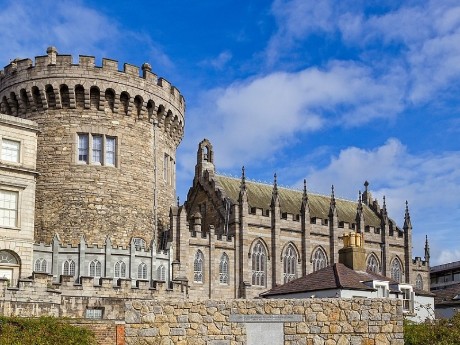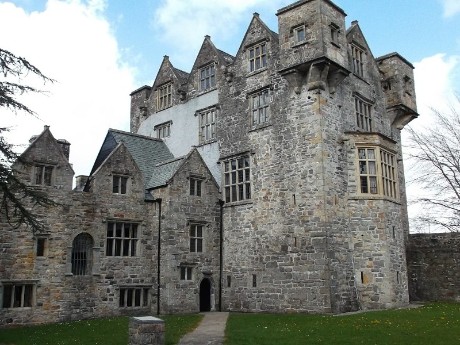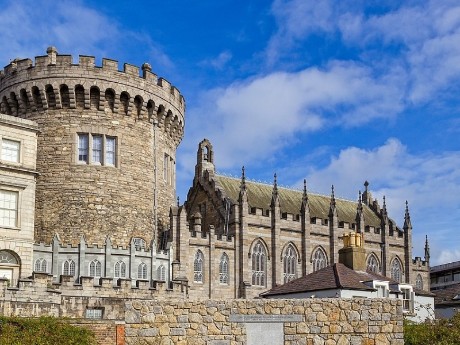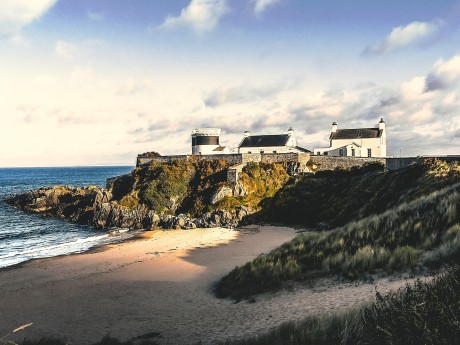Ireland: Dublin & Donegal
Explore the enchanting country of Ireland, brimming with rich history, culture, and awe-inspiring natural landscapes. Begin in the bustling city of Dublin, the capital, which exudes a deep sense of history and culture. Behold the iconic Dublin Castle, or marvel at the exquisite architecture of St. Patrick's Cathedral. Ensure a visit to Trinity College Library, home to the illustrious Book of Kells, or indulge in a pint at the Guinness Storehouse.
Read more
Explore the enchanting country of Ireland, brimming with rich history, culture, and awe-inspiring natural landscapes. Begin in the bustling city of Dublin, the capital, which exudes a deep sense of history and culture. Behold the iconic Dublin Castle, or marvel at the exquisite architecture of St. Patrick's Cathedral. Ensure a visit to Trinity College Library, home to the illustrious Book of Kells, or indulge in a pint at the Guinness Storehouse. Next, venture to Donegal, celebrated for its striking natural beauty. Traverse the rugged coastline, trek the mountains, or embark on a boat ride to spot seals and dolphins. Experience local culture with a visit to Glenveagh Castle and Gardens, or try surfing at one of the pristine beaches. Waterviews strives to offer accommodation options within walking distance of water and/or in an area of touristic interest. Our prices include taxes (but excludes local tourist taxes). Customize your trip to your personal preferences with optional activities (hit the “Add Activities’’) or change hotels, etc. Contact us for customization at no extra cost at: Service@waterviewstravel.com
Destinations
- Dublin
- Donegal
- Dublin
Itinerary
Dublin

The vibrant, world-renowned capital of Ireland is an essential stop in any visit to the country. Dublin is a dynamic hub buzzing with life, and offers something for every traveller with its mixture of historical buildings and modern architecture within a compact city centre. Spend the day visiting museums and learning about Ireland’s literary legends, before sampling some of the famous Irish charm in one of Dublin’s many pubs and enjoying some live music while chatting to friendly and welcoming locals over a Guinness or two.
Read more
The vibrant, world-renowned capital of Ireland is an essential stop in any visit to the country. Dublin is a dynamic hub buzzing with life, and offers something for every traveller with its mixture of historical buildings and modern architecture within a compact city centre. Spend the day visiting museums and learning about Ireland’s literary legends, before sampling some of the famous Irish charm in one of Dublin’s many pubs and enjoying some live music while chatting to friendly and welcoming locals over a Guinness or two.
Additional Information
History
Founded in 841, Dublin was originally settled by Vikings among a population of Celtic tribes. In the 9th century the Danes captured Dublin and had control until 1171 when they were expelled by King Henry II of England. By the 14th century the king of England controlled Dublin and the surrounding area referred to as “the Pale”.
When the English Civil War ended in 1649, Oliver Cromwell took over. Dublin experienced huge growth and development in the 17th century because many Protestant refugees from Europe came to Dublin. By the 17th century Dublin was the second largest city in the British Isles, only behind London, and a period when great Georgian style buildings were constructed that still stand today. Georgian style architecture was popular from 1720 to 1840 during the times when George I, George II, George III, and George IV of England were ruling.
In 1800, the Act of Union between England and Ireland abolished the Irish Parliament. From this point on, the Irish worked to gain their independence from England, which they finally won in 1922. The Easter rising in 1916 and the War of Independence greatly helped Ireland win their freedom.
A failed attempt to take over the several important buildings, among them the General Post Office on O'Connell Street, led to the arrest of hundreds and execution of 15, now considered martyrs for the cause. Many believe that this event helped gain sympathy for the fight for independence from Britain.
Orientation
Dublin is divided by the River Liffey. On the north side of the Liffey is O'Connell Street — the main thoroughfare, which is intersected by numerous shopping streets, including Henry Street and Mary Street, the busiest shopping district in the city. On the south side are St. Stephen's Green and Grafton Street, the second busiest and most upmarket shopping area, Trinity College, Christ Church and St. Patrick's Cathedrals, the main branch of the National Museum, and many other attractions.
Dublin postal districts range from Dublin 1 to Dublin 24. As a rule, odd numbers are given to areas north of the River Liffey, while even numbers are given to areas south of the river (exceptions are Dublin 8 and 20 which span both sides of Liffey). Usually, the lower the district number, the closer to the city centre.
Although some of Dublin's finest Georgian architecture was demolished in the mid-20th century, a remarkable amount remains. At one point these buildings were considered a reminder of the past British imperialism and many were demolished without regard to their beauty and architectural significance and replaced with modernist or pastiche office blocks, parts of St. Stephen's Green (Dublin 2) being a prime example. Thankfully, attitudes have changed significantly, and Dubliners are now rightly proud of their impressive buildings from all eras.
© Sourced from Wikivoyage
Donegal

Donegal is a lovely small town in County Donegal, with a small harbour where the Eske River meets the Donegal Bay and an amusing town centre, known among locals as the Diamond. The town is small enough to walk through on foot, but those looking for alternatives can hop on the water bus from the harbour. Visitors looking for a more active vacation can challenge themselves in Murvagh Golf Club on an 18 hole championship links course or with horse riding.
Read more
Donegal is a lovely small town in County Donegal, with a small harbour where the Eske River meets the Donegal Bay and an amusing town centre, known among locals as the Diamond. The town is small enough to walk through on foot, but those looking for alternatives can hop on the water bus from the harbour. Visitors looking for a more active vacation can challenge themselves in Murvagh Golf Club on an 18 hole championship links course or with horse riding.
Dublin

The vibrant, world-renowned capital of Ireland is an essential stop in any visit to the country. Dublin is a dynamic hub buzzing with life, and offers something for every traveller with its mixture of historical buildings and modern architecture within a compact city centre. Spend the day visiting museums and learning about Ireland’s literary legends, before sampling some of the famous Irish charm in one of Dublin’s many pubs and enjoying some live music while chatting to friendly and welcoming locals over a Guinness or two.
Read more
The vibrant, world-renowned capital of Ireland is an essential stop in any visit to the country. Dublin is a dynamic hub buzzing with life, and offers something for every traveller with its mixture of historical buildings and modern architecture within a compact city centre. Spend the day visiting museums and learning about Ireland’s literary legends, before sampling some of the famous Irish charm in one of Dublin’s many pubs and enjoying some live music while chatting to friendly and welcoming locals over a Guinness or two.
Additional Information
History
Founded in 841, Dublin was originally settled by Vikings among a population of Celtic tribes. In the 9th century the Danes captured Dublin and had control until 1171 when they were expelled by King Henry II of England. By the 14th century the king of England controlled Dublin and the surrounding area referred to as “the Pale”.
When the English Civil War ended in 1649, Oliver Cromwell took over. Dublin experienced huge growth and development in the 17th century because many Protestant refugees from Europe came to Dublin. By the 17th century Dublin was the second largest city in the British Isles, only behind London, and a period when great Georgian style buildings were constructed that still stand today. Georgian style architecture was popular from 1720 to 1840 during the times when George I, George II, George III, and George IV of England were ruling.
In 1800, the Act of Union between England and Ireland abolished the Irish Parliament. From this point on, the Irish worked to gain their independence from England, which they finally won in 1922. The Easter rising in 1916 and the War of Independence greatly helped Ireland win their freedom.
A failed attempt to take over the several important buildings, among them the General Post Office on O'Connell Street, led to the arrest of hundreds and execution of 15, now considered martyrs for the cause. Many believe that this event helped gain sympathy for the fight for independence from Britain.
Orientation
Dublin is divided by the River Liffey. On the north side of the Liffey is O'Connell Street — the main thoroughfare, which is intersected by numerous shopping streets, including Henry Street and Mary Street, the busiest shopping district in the city. On the south side are St. Stephen's Green and Grafton Street, the second busiest and most upmarket shopping area, Trinity College, Christ Church and St. Patrick's Cathedrals, the main branch of the National Museum, and many other attractions.
Dublin postal districts range from Dublin 1 to Dublin 24. As a rule, odd numbers are given to areas north of the River Liffey, while even numbers are given to areas south of the river (exceptions are Dublin 8 and 20 which span both sides of Liffey). Usually, the lower the district number, the closer to the city centre.
Although some of Dublin's finest Georgian architecture was demolished in the mid-20th century, a remarkable amount remains. At one point these buildings were considered a reminder of the past British imperialism and many were demolished without regard to their beauty and architectural significance and replaced with modernist or pastiche office blocks, parts of St. Stephen's Green (Dublin 2) being a prime example. Thankfully, attitudes have changed significantly, and Dubliners are now rightly proud of their impressive buildings from all eras.
© Sourced from Wikivoyage





